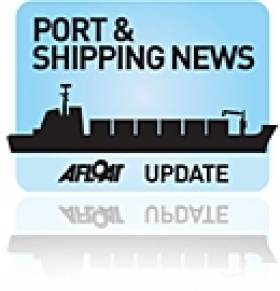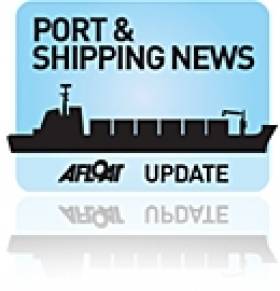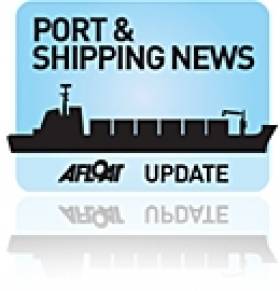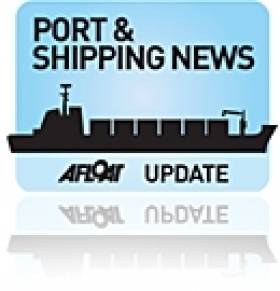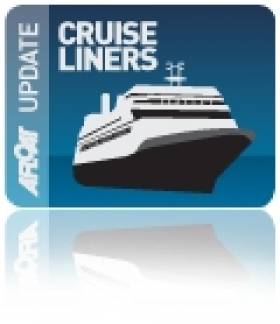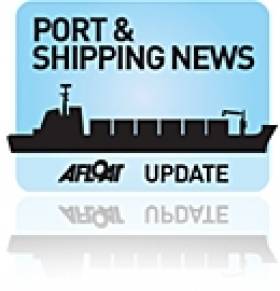Displaying items by tag: Drogheda Port
Drifting ‘Ghost' Ship’s Sister Made Historic Call to Drogheda
#GhostShip – As previously reported on Afloat.ie, the 'ghost' ship Lyubov Orlova, which broke its tow-line in the Atlantic more than three weeks ago is a sister of the first cruiseship caller to Drogheda Port, writes Jehan Ashmore.
The small cruiseship, Lyubov Orlova of 4,251 tons was built in Croatia a year before Clipper Adventurer, which made a historic call to the port on the Boyne last year. Clipper Adventurer, which was at one stage the Alla Tarasova and Lyubov Orlova belong to a series of eight sisters built for the Murmansk Shipping Company.
As ice-strenghtened vessels, they are designed to withstand heavy seas while operating as expedition ships, carrying passengers to both the Arctic and the Antarctic.
According to Travel.aol.co.uk, the drifting vessel is some 1,200 (nautical miles) off Galway.
A report in Canadian news service The National Post says that the Irish Coast Guard is examining satellite imagery to ensure the ship can be retrieved before it breaks apart or drifts into shipping lanes.
Responsibility for the vessel has already been disavowed by the Canadian authorities after the vessel, which was being towed from Canada to the Dominican Republic for scrapping, broke loose from its cabling.
Ports & Shipping Review: Ferry Takes a Battering, Busy Port, Aircraft-Carrier’s Valentine Call, Tanks for Guinness, Cattleship for Libya and much more …
#P&SReview – Over the last fortnight, Jehan Ashmore has reported from the shipping scene, where at Dover, P&O Ferries protested to the Office of Fair Trading over Eurotunnel's bid to manage Calais and Boulogne ports.
The Marine Institute's RV Celtic Explorer called to Dublin Port in between scientific surveys, one in which included a Methane-derived Authigenic Carbonate (MDAC) survey some 25 nautical miles offshore of Dublin Bay.
As a snapshot of Drogheda Port's shipping scene, nine cargoships called within 48 hours, demonstrating the busy Co. Louth port which handled more than 1m tonnes of cargo last year
Passengers booked on a Celtic Link Ferries sailing from France in advance of St. Patrick's Day, will be taking advantage of a special €1 euro fare as part of the year's 'Gathering'celebrations.
Britain's last aircraft-carrier HMS Illustrious (R06) now used as a helicopter commando carrier visited Liverpool on St. Valentine's Day and was open to the public as part of a five-day courtesy call.
Surprised onlookers along Dun Laoghaire's East Pier saw a cargoship, Myrte (6,120 tonnes) loaded with huge silver cylinders. In fact they were fermentation tanks bound for the Guinness St. James Gate Brewery. The tanks were unloaded at Carlisle Pier for onward delivery by road convoy.
An incident involving stabilisers of chartered ferry Finnarrow to Stena Line, while berthing in Holyhead, led to an evacuation of passengers and crew. Stena were forced to reactivate the HSS fastcraft on the route to Dun Laoghaire.
After a break of more than 17 years, a cattleship docked in Waterford, following the lifting of a ban by Libya on beef imports when the BSE (mad cow) disease broke out in Ireland.
There was a mixed response by ESPO and other European organisations to the EU's deal of a budget of €23 billion for transport infrastructure projects over the next seven years.
The UK's Competition Commission has provisionally found that passengers and freight customers could face increased prices following Eurotunnel's acquisition of SeaFrance between Dover-Calais.
Irish Ferries set sail for France when Oscar Wilde launched the 2013 season with a night-time departure on the Rosslare-Cherbourg route.
Transport Minister Leo Varadkar announced a €7.4m funding for a Safety Programme to carry out urgent remedial works at six regional harbours.
Not only were Stena Line forced to reactivate fastcraft HSS Holyhead-Dun Laoghaire sailings earlier than planned (continuing into summer season) but also send in for freight-ferry, Stena Scotia, on the Dublin route following the damaged chartered Finnarrow, currently berthed in Greenock.
On the Celtic Sea, French ferry operator Brittany Ferries Cork-Rosscoff route opens on 23 March for the season service served by flagship Pont-Aven.
Cargoship Faces Detention Over Unpaid Crew Wages
#CARGOSHIP DISPUTE – A cargoship docked in Drogheda Port, Co. Louth, could face arrest if Dutch based Tranship Management, does not immediately pay the crew in unpaid wages, according to Ken Fleming of the International Transport Workers Federation.
Fleming who is the co-ordinator for the ITF in Ireland and Britain, has warned the company that they immediately pay the nine men crew of the Julia, who claim $102,700 is owed in total to them.
The Eastern European crew of the 3,870grt freighter are from the Ukraine, Russia and Lithuania, and they claim they have not had not been paid since May.
Mr. Fleming said, "We are seeking payment in full of the arrears owed to these men, all but one of whom wants to be repatriated because of the intolerable conditions on the vessel".
"The company faces a very simple choice, either they transfer the arrears to their local agent for immediate disbursement to the crew or I will be applying to the Admiralty Marshal of the High Court for the ship's arrest."
The ship built in 2006, has a consignment of 5,000 tons of cement on board for Belgium, however he added "it will be sitting here in Drogheda if the company does not live up to its commitments. The day is long past since this sort of treatment of seafarers was tolerated in Irish ports."
#PORTS & SHIPPING REVIEW – Dublin 'Docklands' floating river-restaurant ship M.V. Cill Airne celebrated her 50th anniversary having been built nearby at the Liffey Dockyard. A special lunch and lecture organised by the Cobh branch of the World Ship Society was held on board the veteran vessel which represents one of the last surviving ships built in Ireland and which remains around our coast having had a rich and varied career.
Along the Shannon Estuary the mid-west port of Foynes welcomed the first cruise call for this year with the arrival of the 28,000 tonnes ultra-luxury Silver Whisper. Passengers from the 382 capacity cruiseship toured the region including the local Foynes Flying Boat Museum.
Returning to the East coast where in Drogheda Port, onlookers welcomed the first ever scheduled cruise call to the Boyne when the Clipper Adventurer berthed at the Co. Louth port to complete a circumnavigation cruise of the island where US and Canadian passengers disembarked.
Down the coast the RV Keary was undergoing refit at Arklow Marine Services yard. The research vessels owners Geological Survey of Ireland (GSI) have chartered the Cosantoir Bradan from the Central Fisheries Board for survey work to assist the RV Keary.
In the capital the veteran grab-hopper dredger Hebble Sand (1963/757grt) departed Dublin Dry-Dock facility in readiness for a new career working with Northern Ireland based Abco Marine. The former Dundalk Port Company owned vessel which resembles the last of the Guinness ships, currently remains in the port awaiting her first delivery voyage for contract project work.
Across the Irish Sea the first of two new offshore patrol vessels (OPV) for the Naval Service had its keel-laid at a ceremony at Babcock Marine's shipyard in Bideford, north Devon. The €99m pair are an enlarged version of the 'Roisin' class L.E. Roisin (P51) and L.E. Niamh (P52) which were launched from the same UK yard over a decade ago then owned by Appledore Shipbuilders.
Drogheda Port to Become New Cruiseship Destination
#CRUISE LINERS- In a first for Drogheda Port, the cruiseship, Clipper Adventurer (1975/4,367grt) is to call next May, and will represent a new business to the port as part of its circumnavigation of the island of Ireland, writes Jehan Ashmore.
The 101m long vessel will bring 236 American and Canadian visitors and a 65 crew, on a cruise organised by Adventure Canada, in association with Royal Canadian Geographical Society.
During the 10-day circumnavigation, the vessel will make calls to the Co. Louth port with passengers touring the Boyne Valley, The Skelligs, Aran Islands, the Gardens on Garnish at Glengariff and Tory Island. They will take in the history, archaeology, bird and marine life, culture, and Irish music in addition to a lecture programme from an on board team.
"With its downtown location, Drogheda Port is perfect for us," says Matthew Swan, president of Adventure Canada.
Last year, Swan visited Drogheda to conduct research for the cruise trip around Ireland. "I heard about your Graffiti and Samba Festivals before coming to town. It seemed like my kind of place, I'm definitely coming back for the Samba event."
Nessa Lally of Drogheda Port commented on the launch of the port as a new cruise destination: "Drogheda Port Company is pleased to announce the inaugural visit of the Clipper Adventurer to our port. This is the beginning of something special for Drogheda and the Boyne Valley.
The area has tremendous potential as a regular cruise destination with world class and potential world class attractions such as Newgrange, Slane Castle, Beaulieu House, the Battle of the Boyne site, the Hill of Tara and medieval Drogheda town itself, to mention just a few.
We will very much welcome the Clipper Adventurer and its passengers to our port and town and intend to give them a memorable visit to our locality. The port company has also commenced a dialogue with a number of interested parties to build and brand a full local itinerary for attracting and growing cruise business and tourism."
In the same month of the inaugural cruise, Drogheda will host a second cruise also by Clipper Adventurer, with Danish passengers organized through Copenhagen-based tour operator, Albatros Travel. They will undertake a 10-day Irish and Scottish itinerary that finishes in Bergen, Norway.
Clipper Adventurer is an exploration vessel which otherwise is often found cruising in polar waters, either Antarctica or the Arctic from Spitsbergen through Iceland, Greenland and Canada's Northwest Passage.
Over the last decade she has called to several Irish ports to include a once-off call to Arklow, where the Serbian-built vessel anchored offshore.
To Russia with ‘Potatoes’
Asides the cash crop, Drogheda Port has established shipping trades routes in the carriage of containers units, fertilizers, magnesite, LPG and newsprint. In addition the Co. Louth port operates the country's only weekly service to Norway, Sweden and Denmark.
Tankers Thresher To Twaite Break Drogheda Records
The Twaite surpasses the previous record only set on 19 August when the smaller 100m Thresher called to Drogheda. Like the Twaite, the Thresher is owned by Chemgas. The Dutch company's inaugural arrival in August represented a new shipping operator to the Co. Louth port. The 4,750 dwt Thresher was built in 2006 and had discharged 1,300 metric tonnes of the cargo at the Flogas facility which employs 100 staff.
Drogheda Port
Drogheda Port
Drogheda Port is one of Ireland’s premier multi modal ports strategically located on the east coast with direct motorway access to the country’s key industrial and commercial centres. The port is continuing to develop and expand by offering its customers a strategic locational advantage in an increasingly competitive marketplace.

We have built a solid reputation on our high levels of customer service, flexibility, and the rapid turnaround of vessels. Few ports boast such a prime position for taking advantage of the ever increasing opportunities in European and Scandinavian trades, in addition to the emerging markets of Eastern Europe and the ever changing patterns of short sea container trade.
Drogheda Port has established itself as Ireland's gateway to Scandinavia with the country’s only weekly service to Norway, Sweden and Denmark. The port is also Irelands major distribution and logistics centre for newsprint.
Drogheda Port Company is a highly successful commercial state port which handles over 1.4 million tonnes of cargo annually in addition to over 700 vessel calls. Throughput for 2005 totalled 1,401,555 million tonnes.
The Company provides port facilities for both general freight and container services, and has a record of continuous growth in both.
The Port has a wide product base and a balance of trade at approximately 75% import and 25% export. We are a natural choice for a wide range of customers and trades, with facilities to handle virtually any type of cargo.
Imports include Containers, Paper, Steel, Timber, Fertilizer, Grains, Petroleum and Liquefied Petroleum Gas. Exports include Containers, Magnesite, Zinc Concentrate and Timber.
Geographically, the Port is situated on the historic River Boyne on Ireland's east coast with direct access to both Dublin and Belfast on the M1 Motorway. The port's position on the east coast of Ireland provides a major geographical advantage for transport links in to and out of Ireland. As a result, the port has very strong short-sea trade links with Europe, Scandinavia and the Baltic states. Regular and frequent general cargo and container services to Norway, Sweden and Denmark have established Drogheda Port as Ireland's Gateway to Scandinavia.
The Port has built its reputation on high levels of customer service, flexibility and the rapid turnaround of vessels. A container service operates from Tom Roes Point Terminal and presently provides a twice weekly service between Drogheda and Rotterdam.
Facilities
The Drogheda Port Company has two facilities for the loading/discharging of cargoes, i.e. the inner north quays port and the deep-water facility at Tom Roes Point Terminal. In addition there are two private facilities. The approach and estuarial channel is maintained to a depth of 2.2m at Chart Datum to the deep water facility at Tom Roes Point, 5 km from the sea, and at 0.8m at Chart Datum to the inner port 7 km from the sea. The port can currently accommodate vessels up to 120m LOA.
The deep-water facility at Tom Roes Point is the primary container/paper and timber handling facility. The berth is 160m in length with an always-afloat dredged pocket of 6m at Chart Datum over a length of 210m. The berth can accommodate single vessels operations up to 120m LOA or two vessel of 100m LOA. There are on site open storage facilities of circa 14 acres and a paper store of 90,000sq ft. Primary handling is by two Liebherr LHM 250 harbour mobile cranes with additional tracked grabbing cranes. Secondary handling is by a modern fleet of dedicated container handling and general purpose forklifts. The inner north quay port is a general cargo facility catering for bulk grains, steel, timber etc. The 4 berths consist 430m of quay. Three of the berths have an air draft restriction of 27.5m at MHWS. Primary cargo handling is by a combination of harbour mobile and crawler cranes with appropriate secondary handling.
A private hydrocarbons facility can accommodate vessel of up to 80m LOA, in a dredged pocket of 2.2m at Chart Datum. The oil terminal has a current capacity of 10,000m3 of Class 1, 2 and 3 products, plus, 1,500m3 capacity at the LPG terminal. A private bulk cement/magnesite/coal facility can accommodate two vessels on a 160m berth.
A Brief History of the Port
We can never be certain as to when man first sailed up the River Boyne, but we do know it would have looked a very different place then. The evidence points us to a date around 3,000 B.C. when middle Stone Age man arrived. They sailed their boats into the mouth of the river and progressed as far as Newgrange. The landscape at the time would have been heavily wooded and the Boyne itself much wider and slower moving.
Drogheda provided a natural ford on the river at the current site of St. Mary’s Bridge from where the first houses and quays were built. From that era to the current day the port has progressed into an important commercial highway trading with Europe, Scandinavia, Asia and America.
It is said that Saint Patrick landed at Colpe in 432 AD and in 937 AD it is recorded that there were 60 Viking ships on the Boyne and 60 on the Liffey as they plundered the ancient sites of Ireland. The vikings returned to the Boyne on many occasions and used the port as a base for their plundering expeditions.
In the 1400’s goods were coming from all over Europe to Drogheda Port. Archaeological excavations over the years show Drogheda to have been a very cosmopolitan town due to the ports trading links with the outside world. Pottery from Bordeaux, Gascony and Flanders have been found.
Wine from France was a very important trade at this time with up to two to three ships per week fully laden. Goods such as hides and corn form the local region were exported to places like Gdansk, Lisbon and Iceland.
Moving on through the 16th Century Drogheda had developed a good trading relationship with Liverpool exporting mostly linen and flax. This relationship further developed in the 1800’s when Drogheda had a regular passenger steamer service to Liverpool. The steamers would sail initially 2/3 times a week and were the first in the world to have electric light on board. The service further expanded some years later to become a daily service and include Glasgow on the route.
The journey to Liverpool then took over 14 hours and could be very hazardous and uncomfortable, where today it would just take over 3 hours on the new generation high-speed ferries. The ships carried a mixture of cattle and passengers, and sometimes the cattle were better treated. The first steamer in 1826 was called the 'Town of Drogheda', and many others followed.
Many ships were also build in the port and Grendons foundry which was established in 1835 employed up to 600 people and produced many steel ships which were launched on the Boyne.
In the 19th century Drogheda became one of the ports through which thousands of Irish people emigrated from famine and out to the new world.
The most striking visual feature in the Port is the Viaduct which was build in 1855 for a total cost of only £124,000 and is still as solid and functional today as the day it was built.
Work on the quays in the old days was hard and dirty with cargoes such as coal having to be shovelled out of the ships hold by hand. It took many dozens of men to do this work on each ship. Today there is a different picture with technology and mechanisation, loading and unloading large amounts of cargo from ships has become much quicker.
Ships today are better designed and have more technology allowing them to predict and manage bad weather and as a result a have much safer passage.
The management of the port began a new era in 1997 when the Drogheda Harbour Commissioners were dissolved after over 200 years and the port became a new commercial semi-state company, Drogheda Port Company.
A new deepwater terminal has been constructed at Tom Roes Point which will be capable of handling larger vessels than the inner port was capable of. Vessels carrying up to 5,000 tonnes of cargo and up to 120 metres in length will use the new facility. New short sea shipping routes have developed from the terminal particularly in unitised trade. As ships have been getting larger there has been a slow progression for the port seaward. Up to the 1800’s ships were unloaded as far up the river as St Mary’s bridge. The main working quays gradually moved to the Ballast, Welshmans and Steampacket quays and now new berths are operating at Tom Roes Point Terminal.
Drogheda Port has always been an integral part of the town economy and played a major role in its outward looking nature. The industrial base of the town was established through the port and it will continue to be a vital element in the town’s future growth.
Drogheda Port, Harbourville, Mornington Road, Drogheda, Co Meath
Sat Nav Co-Ordinates N 53.43.148 W 6.18.468
Telephone – Ireland: 041 983 8378 • International: +353 41 983 8378
Fax – Ireland: 041 983 2844 • International: + 353 41 983 2844
Email – General: [email protected]




























